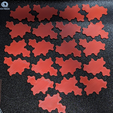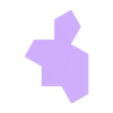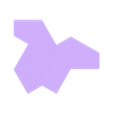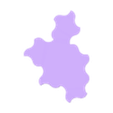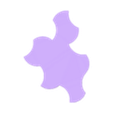Monotiles
This project implements patterns for monotiles as published by David Smith, Joseph Samuel Myers, Craig S. Kaplan, and Chaim Goodman-Strauss.
- The original An aperiodic monotile that describes a tile shape, called a "Hat," that tiles the plane aperiodically but requires using some reflected (upside-down) tiles.
- The follow-up A chiral aperiodic monotile that describes a tile shape that can tile the plane periodically, if reflections are disallowed, and by modifying the edges into any of a class of shape they call a "Spectre," can tile the plane only aperiodically.
In practice, we found that printing the exact models of the tiles failed to assemble perfectly because of printing artifacts. The pattern would spread apart due to imprecision and artifacts, and ultimately fail to tile.
To address this fault, each of these models is inset by 0.25mm around the perimeter, and has all convex vertices filleted with a 0.5mm radius. This has, in practice, enabled a good fit enabling substantial tiling. If, as printed on your printer, your tiles do not pack well, you can modify the inset in the model to accommodate your setup.
Each of these tiles is modeled in FreeCAD, an Open Source CAD package, using essentially the same technique:
* Draw a sketch on the XY plane that expresses the nominal shape, fully constrained, with a single driving dimension (e.g. based on the length of a side).
* Use the Draft workbench 2D offset tool to create a -0.25mm offset (a 0.25mm inset) from that base sketch.
* Hide the sketch, open the Part Design workbench, select the offset, and create a new body.
* In the new body, select the BaseFeature and pad it 3mm
* Select one edge representing a convex vertex, fillet, set 0.5mm radius, then select all other convex vertices.
If you want to modify these tiles, find the sketch inside the 2D offset at the top of the model, find its contraints, and change the 15mm BaseLength and/or (on the chiral models) the equation for the radius of the arc sections that force chirality. Similarly, if with your printer, you need additional inset, you can modify the 2D Offset to have a larger inset, changing -0.25 to something of slightly higher magnitude. Conversely, if you are printing this on a very well-tuned printer, you might reduce it slightly so the tiles fit snugly.
It is best to print at least 8 or so tiles to test their fitment before committing to a large print run.
Einstein
The "EinStein" files model the original "Hat" shape from the first paper. If you want to print different colors for upright and flipped tiles, the proportions of the colors to print depend on the number of tiles you are printing; for example, for 48 normal tiles, print 7 flipped tiles. Alternatively, you could print the bottom in one color and switch colors halfway through printing, to make all tiles two-colored.
Chiral
The second paper proposes a weakly chiral tile (chiral under fiat forbidding flipping) which it calls "Tile(1,1)" (here, files named "WeakChiral"), and two examples for side modifications that force chirality. One with dual-curved, S-shaped edges, and one with single curved, C-shaped edges. These strongly chiral tiles the paper calls "Spectres". For the purpose of file naming, The S-shaped edges are called "SSpectre" and the C-shaped edges are called "speCCtre" (the letter is doubled so that the files do not conflict on Windows systems that do not respect case in file name). These C-curved and S-curved shapes will not mesh inverted, and so enforce the fiat not to flip them over.
Don't want to print them? See this delightful laser-cut puzzle instead:
https://n-e-r-v-o-u-s.com/blog/?p=9333
Maintained in Gitlab
Inasmuch as any copyright applies to these mathematically-defined
files, use them under CC0 terms:
https://creativecommons.org/publicdomain/zero/1.0/

/https://fbi.cults3d.com/uploaders/14535803/illustration-file/a7ef9a79-2b58-41d7-a2fc-2d19d8569067/Screenshot-from-2023-09-05-18-50-38.png)
